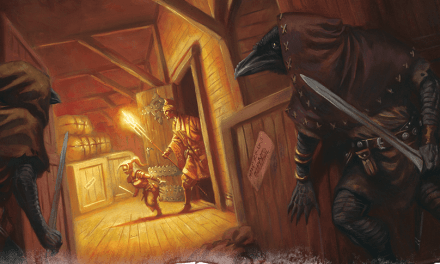When you mix real-world physics and the rules of D&D (or any tabletop game, really), weird things happen.
I can’t think of any better examples than the infamous force of nature that is the “Peasant Railgun.”
I recently saw a TikTok video where the creator was talking about this concept. It stirred something up in me and I knew I just had to talk about this in an article.
With promises of incredible speed and hilarious damage output, we’re going to look closer at this idea.
Is it possible to hire an army of peasants and create a possibly campaign-ending superweapon with them?
Read on as we tackle the myth of the legendary Peasant Railgun in D&D 5e!
What Is The Peasant Railgun in D&D?
The theory behind the Peasant Railgun is pretty straightforward:
Line up a bunch of peasants (or skeletons or goblins or whatever other reasonably intelligent creatures) and have them take the “Ready” action. When the peasant is handed the item they immediately pass it to the next peasant down the line.
The item could be a rock, spear, bucket, 10-foot pole, or whatever else. Ultimately, as the theory goes, the item doesn’t entirely matter.
The final peasant in the line has a different Ready action than the others. This peasant has instead used their Ready action to throw the item at a target once the item has been handed to them.
By handing the item to the first peasant in the line, you start the Domino Effect of peasants passing the item down the line and towards the final peasant who is ready to throw the object at their target.
Because a single round in D&D 5e is 6 seconds long regardless of how many reactions happen, it would take only 6 seconds for the item to be passed down the entire line and, ultimately, yeet-ed at whatever poor target the final peasant is aiming at.
How Does the Peasant Railgun Work?
The idea behind the Peasant Railgun is that the item would be accelerating to an incredible rate and therefore deal a colossal amount of damage simply because of the force behind the item.
Let’s say you round up 1000 peasants (each occupying a 5-foot square) and give them instructions. In theory, the item being passed down the line has traveled an astounding 5000 feet in 6 seconds.
We’ll go into more detail about the math on this in just a bit.
But even without exact math, you can easily get the point that anything traveling THAT fast will deal some incredible damage to whatever it collides with.
As the theory goes, the thing that this object collides with is an incredibly unlucky enemy who quite literally never saw this coming.
They may have heard it coming though.
You know… considering that all but the first couple hundred peasants are likely screaming in pain as their arms are ripped off as they pass a rock at mach-speed.
You see where this is going…
Check This Out: The 6 Best Books That Every DM Needs To Read!
Is a Peasant Railgun Possible?
The quick and dirty answer to whether a peasant railgun is possible or not is: no.
For this to work as intended, you would need two things:
- A set of rules that mixes real-world physics with D&D game rules to create something not quite as good as either.
- A DM who either doesn’t understand the rules of the game or can’t be bothered to care.
If we’re taking the RAW (rules as written), the party could theoretically hire a bunch of peasants, stand them in a line, and have them pass objects to each other.
However, the final peasant in the chain would then just be making a standard improvised weapon attack. He rolls 1d20+STR for the attack to deal 1d4+STR damage if it hits.
The acceleration of the item being passed down the line of peasants doesn’t change this.
For the Peasant Railgun to work as intended, you have to do a TON of physics homework and then ignore the 5e rules to substitute your own damage with the goal of being “realistic.”
Ultimately, the point of the rules in 5e isn’t to be hyper-realistic. They’re meant to provide a framework for the game to take place while giving DMs plenty of resources to help them adjudicate situations accordingly.
Of course, there’s also Rule Zero which is basically that the DM has the final say on what goes.
We’ll get to that shortly.
But first, let’s do some math!
The Math
Alright, so let’s break this down.
For the sake of this example, let’s say that the party has lined up 1000 peasants and given them their instructions as we described earlier. Each peasant occupies a 5-foot space which means that this line stretches 5000 feet.
All but the final peasant has readied the action to pass the rock to the next peasant in the line. The final peasant will throw the rock at the enemy goblin, Zekke the Unfortunate.
5000 feet away from Zekke, the party hands the rock to the first peasant in line. Zekke watches on in horror.
The rock travels 5000 feet in 6 seconds (833.33 feet per second) or an average of 567.95 miles per hour.
Now, let’s say 1000 peasants just isn’t grand enough for your tastes. Let’s up that to 10,000 peasants!
In this exercise, the rock travels 50,000 feet in the same amount of time (6 seconds) that it would take to travel 5000 feet. With 10,000 peasants, the rock is traveling at 8333 feet per second or 5681.6 miles per hour!
For reference, the fastest bullets travel at around 1,800 miles per hour. The speed of light is 186,000 miles per second. This is faster than an F-15 fighter jet which has a top speed of 3,017 mph.
As the screaming peasants continue to pass the rock down the line, the final peasant throws the rock at our poor Goblin target. Zekke presumably explodes and the rock continues on its trajectory doing untold damage to whatever happens to be in its path.
You can certainly go deeper with this calculation if you would like. Tracking the rate of acceleration to determine at exactly what point in the line these peasants will start losing limbs as they pass something moving faster than a fighter jet.
I’m terrible at math and physics so the calculations beyond the basic average aren’t exactly my forte. If someone out there who enjoys calculating these things wants to give it a crack, let me know what you find!
Should You Allow Players To Make A Peasant Railgun?
Ok, this might be a bit of a controversial take that even kind of contradicts my tone earlier in this article.
If your group expresses interest in creating a Peasant Railgun and you are playing a game that is basically purely comedy, then go for it.
If you are playing a more serious game with a driving story, I would strongly recommend against trying to make this work. Lining up peasants to throw rocks at 3,000mph into (and through) the BBEG’s fortress to assassinate them is possibly one of the most surefire ways to derail an entire game.
As the DM, you are more than welcome to allow the players to line up their peasant army only to find that their idea doesn’t work. (I’d still warn them ahead of time though…)
At the end of the day, it’s about having fun. If this is your group’s idea of fun and it doesn’t compromise all of the work that has been put into the story so far, then why not.
Just promise me one thing:
If you DO (for some reason) decide to allow your players to do this, please use it yourself as well (and let me know how it goes!). Send them running out of a dungeon screaming as a necromancer lines up 1000 zombies and hands the first one a rock.
You Might Also Like: What Every Dungeon Master Can Learn From South Park
Mixing Physics with D&D Rules is a Bad Idea
Ok, so I haven’t ever met someone who chose to go all-in in favor of building a Peasant Railgun. I’m willing to bet that cases where a player is genuinely and with 100% seriousness attempting to make this happen in their game are incredibly rare.
I mean, ultimately, the concept of this thing is itself just people being silly. There are likely hundreds of different reasons why it just simply doesn’t work.
But this does touch on something more common than lining up hundreds or thousands of townspeople with the singular intention to throw things very fast and very hard.
As I mentioned, the theory behind the Peasant Railgun relies on creating some strange and selective hybrid of the rules of D&D 5e and physics.
Honestly?
Any time that you try to apply real-world physics and science into a Fantasy game, it’s never going to be clean. Just look at 5e’s rules for Falling Damage for example!
Without fail, refusing to take the game’s world and rules for what they are will almost always lead to long, passionate, and ultimately pointless arguments.
As a good friend of mine would say, “stop overcomplicating a marshmallow.”
For the same reason that the game’s rules and the DM’s usage of them shouldn’t be used as a club to punish and restrain players from telling a great story together, your game shouldn’t just be people arguing about the rules.
As a DM you sometimes have to say “no, this is how it is” and move on. The Peasant Railgun is exactly such a situation.
So enjoy the game and suspend your disbelief so that you can fully explore the world that is being created at your table!
Trust me, there are plenty of ways to harass your DM without needing to bust out the calculator and a physics book!
Conclusion – The Peasant Railgun in D&D
It’s very difficult to talk or write about the Peasant Railgun with a straight face. The concept is so hilarious and absurd that the mental image led to me accidentally choking on my coffee several times while writing this.
Ultimately, I think it’s just a funny thing to talk about.
Are there any world-breaking spells or mechanics that you have heard of?
Let’s talk about them in the comments!
And speaking of world-breaking, you might be interested in the tale of Gimble Pamplemousse, the gnome who (basically) built a Death Star!









